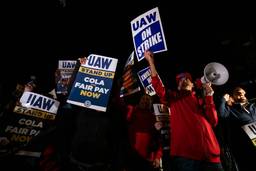
On March 18, the Department of Labor (DOL) announced it would resume processing applications for the H-2B guestworker program after a two-week suspension. The DOL abruptly halted processing H-2B applications earlier this month after a Florida federal district court ruling left the program without any formal regulations; the agency began processing applications again when the court granted its request to stay the ruling until April 15 to allow the guestworker program to continue. The announcement prompted a collective sigh of relief among employers and workers who depend on H-2B jobs.
The program, which brings foreign workers to the U.S. to fill temporary labor shortages, is commonly used in landscaping, forestry, carnivals, seafood and hospitality. News of its shutdown — which did not come with a clear end date — sent these industries into a frenzy and inspired the Twitter hashtag #saveH2B. Many of the #saveH2B tweeters were landscaping companies, by far the biggest users of H-2B.
Despite the stay allowing the program to continue functioning, H-2B is not out of the woods yet. The stay lasts only through April 15, and new regulations aren’t slated to come out until April 30. That means another two-week suspension is likely, and it could be longer if the regulations are delayed.
The seeds of the suspension were planted in Bayou Lawn and Landscape Services v. Solis, a lawsuit H-2B employers and industry representatives filed asking the Florida court to block H-2B regulations that the DOL issued in 2012. Those regulations included worker protections that a set of 2008 regulations, issued in the twilight hours of the Bush administration, did not: workers were guaranteed contracts, three-fourths of the hours in those contracts (as guestworkers are not actually guaranteed the full number of hours listed in their contracts) and reimbursement for travel to and from the U.S., for example.
The plaintiffs said only the Department of Homeland Security, not DOL, has authority to regulate the H-2B program. The court agreed and blocked the 2012 regulations, but left the 2008 regulations in place. Noting that employers never objected to the 2008 regulations, workers’ advocates say the employers’ real complaint was not DOL’s lack of authority to issue regulations but the fact that the 2012 rule included worker protections. Once the court had blocked the 2012 rule, however, workers’ advocates argued that it should block the 2008 rule as well. It did so on March 4, leading to the temporary shutdown of the program.
One of the most frequent #saveH2B tweeters was the Professional Landcare Network (PLANET). PLANET was a plaintiff in Bayou Lawn, the case that blocked the 2012 rule — and indirectly prompted the program’s shutdown and the call to save H-2B. The landscaping association’s comments seemed to confirm workers’ advocates’ claims that Bayou Lawn was primarily intended to prevent the worker-friendly 2012 rule. PLANET says on its website, “We need to ensure that none of the 2012 H-2B program” regulations make their way into the interim rule set to come out on April 30. Tom Delaney, PLANET’s director of government affairs, says that rule is too demanding of employers. “It will kill the program,” he says.
Not all guestworker advocates think that would be a bad thing. While one faction of advocates calls for a rule modeled on the 2012 regulations, another would prefer to see the program die.
“I say let H-2B disappear for a while,” tweeted Daniel Costa, the director of immigration law and policy research at the Economic Policy Institute (EPI).
Although the EPI supported the 2012 regulations, Costa doubts the need for the program. He says data over the past 15 years shows that in the top H-2B occupations, “unemployment rates are really, really high — I’m talking double digits at least — … and the wages have been completely flat.” Employers are only supposed to use H-2B workers if they cannot find U.S. workers first. But high unemployment and stagnant wages “are not the indicators of some big national labor shortage,” Costa says.
He adds that not only are guestworker programs unnecessary for low-skill, temporary jobs, but they’re often abusive. “There’s a growing global consensus that temporary worker programs are a version of slavery, or lead to it in many cases,” Costa says, citing extreme abuses in places like Qatar. He could just as easily have chosen a domestic example: last month five Indian H-2B workers won a $14 million settlement for forced labor and human trafficking.
Bill Chandler, executive director of the Mississippi Immigrants Right Alliance (MIRA), agrees. MIRA is part of a coalition called the Dignity Campaign that calls for more immigrant- and worker-friendly alternatives to existing proposals for comprehensive immigration reform. It proposes ending guestworker programs, including H-2B, after five years.
One problem with the guestworker model, Chandler says, is that it weakens workers’ ability to bargain collectively and assert their rights. “It undermines the power that they have,” he says, “because the workers are divided.”
He and Costa agree that if there are real labor shortages, foreign workers should be able to enter the U.S. with a path to citizenship and the freedom to change employers — both of which they lack under H-2B. In times of high domestic unemployment, visas for foreign workers could be reduced or suspended.
Jim Knoepp, who runs the Immigrant Justice Project of the Southern Poverty Law Center (SPLC), agrees with these criticisms of guestworker programs. The SPLC, a nonprofit civil rights organization, has been equally damning in its criticism. Its report on H-2B and its agricultural counterpart H-2A, “Close to Slavery,” documents widespread debt bondage, wage violations, squalid conditions and lack of medical care. But it was also among the groups that urged a new, more protective rule modeled on the 2012 regulations.
Knoepp isn’t against abolishing guestworker programs in theory. “If employers can’t agree to some basic protections for these workers, maybe the program really should be ended,” he says. But he doesn’t see that happening anytime soon. “You need to work within what the political climate provides right now,” says Knoepp. “It’s not going to end, and it needs to be fixed so that you don’t continue to see these abuses.”
While many H-2B workers are unhappy with the abuse and exploitation they suffer on the job, that doesn’t necessarily mean they want the program to go away. Adarely Ponce Hernandez has worked various H-2B jobs, most recently crawfish processing in Louisiana. She knows firsthand some of the problems with the program, having been defrauded three times by false recruiters for H-2B jobs.
But she told me that her community in the Mexican state of Hidalgo depends on the jobs. Her only employment comes from working in the U.S. “The majority of women who go are single mothers,” she says. “The people who are going to be most affected by this will be their kids.”

I hope you found this article important. Before you leave, I want to ask you to consider supporting our work with a donation. In These Times needs readers like you to help sustain our mission. We don’t depend on—or want—corporate advertising or deep-pocketed billionaires to fund our journalism. We’re supported by you, the reader, so we can focus on covering the issues that matter most to the progressive movement without fear or compromise.
Our work isn’t hidden behind a paywall because of people like you who support our journalism. We want to keep it that way. If you value the work we do and the movements we cover, please consider donating to In These Times.





